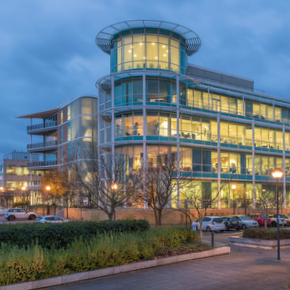
Simple steps to SBEM compliance
 Complying with Part L2 of the UK’s Commercial Building regulations doesn’t have to be a nightmare. Marcus Eves, Technical Lead at Darren Evans Assessments, shows how a simple SBEM methodology can prevent this becoming a major drama.
Complying with Part L2 of the UK’s Commercial Building regulations doesn’t have to be a nightmare. Marcus Eves, Technical Lead at Darren Evans Assessments, shows how a simple SBEM methodology can prevent this becoming a major drama.
SBEM (Simplified Building Energy Model) compliance
SBEM stands for Simplified Building Energy Model and is the current method of assessment to demonstrate compliance with Part L2 of the building regulations. It takes into account the amount of energy used by a building to condition the internal environment. The heating, cooling, hot water, lighting and ventilation demands all play their part in contributing to the amount of CO2 the building emits.
To reduce emissions, Part L2 sets heat loss targets for the fabric, as well efficiency targets for the building services. Part L2A says an SBEM assessment is compulsory for all new build non-residential buildings with a floor area greater than 50m2. There’s no one-size-fits-all approach. But there are key areas which can make improvements to your results and are common across most building types.
Fabric First
Achieving a well-built, thermally efficient, air tight building gives greater flexibility regards specification of the building services. Under the requirements of Part L, buildings under 500m² are exempt from an air permeability test. A voluntary air test on a smaller building can be a very cost-effective way to hit the emission targets.
Heating
Selecting a heating system compatible with the operation of the building will ensure your route to compliance is straightforward. Sticking to centralised systems is most effective and unless there is no other option, avoid localised electric heating. If the building isn’t connected to the gas network, opt for ground or air source heating.
If space permits, consider biomass or switch to using CHP to simultaneously produce heat and electricity. This is proven technology where the building has high heat and hot water demands such as a hotel or student accommodation.
In warehouses or other spaces with high ceilings, consider radiant heating as it will warm people and objects rather than increase air temperatures. If traditional hot air systems are installed, you can install de-stratification fans to ensure an even temperature balance across all levels.
Ventilation & Cooling
Introducing mechanical plant into the building increases your electricity consumption and emissions. Design maximising passive strategies, focusing on utilising thermal mass, heat gain control and heat dissipation along with natural ventilation. For installed mechanical plant, ensure that the system is appropriate for the size of the space to maximise effectiveness. Choose air conditioning cooling systems with high heating and cooling efficiencies.
Lighting
LEDs should be your main consideration for all lighting applications. They are highly efficient and now, relatively inexpensive. Coupling the bulb selection with an effective controls strategy utilising passive infra-red or photoelectrics will ensure wasted energy is kept to a minimum when lighting is not required.
Renewables
Bolt on renewables should be your last resort when designing a building. The fabric first approach is proven to be successful which we can see in Passivhaus design.
Implement a renewable strategy if you have adequate south facing roof space for photovoltaic panels or open space for wind turbines etc, but don’t rely on these technologies to get you over the line.
The above is just a selection to consider. It’s certainly not an exhaustive list as there are so many other factors to consider including how they all fit together. Don’t be constrained by simple compliance. Look to a bigger picture, taking a holistic view on energy saving and sustainability and you’ll be guaranteed success every stage
For more information about SBEM compliance contact Darren Evans Assessments.
Latest news

19th April 2024
ASSA ABLOY: Access solutions can impact sustainability performance across the full life-cycle of a building
Embedding sustainability within any organisation requires a broad, strategic perspective. Scrutiny should include the physical infrastructure itself: According to the IEA, buildings consume around 30% of global energy*. ASSA ABLOY has more…
Posted in Access Control & Door Entry Systems, Architectural Ironmongery, Articles, Building Industry News, Building Products & Structures, Building Regulations & Accreditations, Building Services, Case Studies, Doors, Facility Management & Building Services, Information Technology, Research & Materials Testing, Retrofit & Renovation, Security and Fire Protection, Sustainability & Energy Efficiency, Video of the Week
19th April 2024
British weather doesn't dampen spirit for new HMG Garden Paint
Despite one of the wettest starts to the year on record, customers are starting to plan for brighter days with HydroPro Garden Paint from HMG Paints.
Posted in Articles, Building Industry News, Building Products & Structures, Garden, Innovations & New Products, Paints, Paints, Coatings & Finishes, Restoration & Refurbishment, Retrofit & Renovation, Site Preparation, Sustainability & Energy Efficiency, Waste Management & Recycling
18th April 2024
Abloy UK showcases new digital portfolio at The Security Event 2024
Abloy UK is set to unveil its latest line-up of access control systems at The Security Event 2024, welcoming guests to explore its cutting-edge electromechanical and digital solutions on stand 5/F50.
Posted in Access Control & Door Entry Systems, Architectural Ironmongery, Articles, Building Industry Events, Building Industry News, Building Products & Structures, Building Services, Doors, Exhibitions and Conferences, Facility Management & Building Services, Health & Safety, Information Technology, Retrofit & Renovation, Security and Fire Protection
18th April 2024
Strand is a Failsafe Choice for Emergency Exit and Panic Hardware
In times of emergency, you’re in safe hands with Strand Hardware. Although there are many considerations for building specification, few decisions can be as critical as selecting the right emergency exit/panic hardware.
Posted in Access Control & Door Entry Systems, Architectural Ironmongery, Articles, Building Industry News, Building Products & Structures, Building Services, Doors, Facility Management & Building Services, Health & Safety, Restoration & Refurbishment, Retrofit & Renovation, Security and Fire Protection
 Sign up:
Sign up: